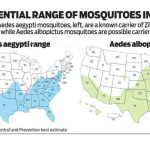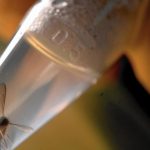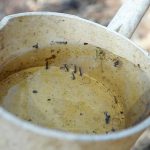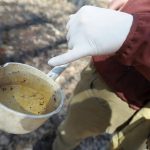The battle against Zika
 The battle against Zika is on in the Lehigh Valley
The battle against Zika is on in the Lehigh Valley
By Sam Kennedy From The Morning Call
How you can help in the fight against Zika
The pesticide, Altosid, contains a chemical compound called methoprene that will prevent mosquito larvae from reaching maturity in the tiny wetland, hidden in a patch of woods surrounded by homes in Alburtis.
Such efforts only do so much good, explained Bugbee, who is in charge of mosquito control for the Lehigh County Penn State Cooperative Extension. That’s because the particular species that might transmit Zika is far more likely to lay eggs in standing water around people’s homes — in bird baths, plant pots and clogged gutters, and even in litter.
“I’m not authorized to go onto private property. … It’s out of my range,” she said. “We say mosquito control is everybody’s business.”
That’s a message health officials are spreading with a growing sense of urgency.
On Wednesday, the Centers for Disease Control and Prevention announced a peer-reviewed study confirmed for the first time that, as suspected, Zika can cause microcephaly in babies born to mothers who were infected with the disease during pregnancy.
In a call with reporters, CDC Director Tom Frieden noted that never before had birth defects been linked to an illness spread by mosquitoes. What’s more, microcephaly, or an abnormally small head, could be just “the tip of the iceberg” if brain damage and developmental issues surface in seemingly healthy babies who were exposed to Zika in utero, he said.
Zika has also been linked to two debilitating diseases that affect adults: Guillain-Barre syndrome and encephalomyelitis. GBS is a disorder in which the body’s immune system attacks part of the peripheral nervous system, sometimes causing partial paralysis. Encephalomyelitis causes a temporary swelling of the spinal cord or brain, resulting in symptoms that resemble multiple sclerosis.
“Everything we look at with this virus seems to be a bit scarier than we initially thought,” said Anne Schuchat, the CDC’s principal deputy director.
Zika, discovered in Africa in 1947, had never been a threat in the Western Hemisphere until last year, when it was found in Brazil. Since then, the virus has quickly spread north through much of Central America and the Caribbean, including Puerto Rico.
So far, Zika does not appear to have gained a foothold in the United States. Of more than 350 confirmed domestic cases, all but a half dozen transmitted sexually have been travel-related, according to the CDC.
Many public health experts, however, believe that could change this summer when North American mosquito populations boom. The threat prompted President Barack Obama to ask for $1.9 billion in emergency funding for mosquito control, vaccine research and other programs to combat the virus — though Congress has yet to approve the funds.
Anxiety is mounting in the absence of action. On Friday, the Pennsylvania Health Department issued a statement asking travelers from Zika-affected areas to “take precautions to avoid mosquito bites” in the week after returning home, even if they are not experiencing symptoms, “to limit the introduction of this virus to local mosquito populations.”
Zika is transmitted by at least one species of mosquito — the aedes aegypti, whose potential range, according to the CDC, includes southeastern Pennsylvania — and maybe by two. The second — the aedes albopictus, or Asian tiger — has a small but growing population in the Lehigh Valley.
“Every year I see more and more [Asian tigers],” said Bugbee, who uses traps to conduct mosquito surveillance.
The Asian tiger, which has distinctive black and white stripes, is believed to have arrived in the United States in 1985 in a load of tires from Japan. From there, it spread quickly across the southern states, eventually penetrating colder climes farther north.
Of the 3,500 species of mosquitoes worldwide, 176 can be found in the United States. Generally, mosquitoes consume nectar. Only female mosquitoes bite people. They need the blood to feed their eggs — from 150-200 in a batch.
POTENTIAL RANGE OF MOSQUITOES
Of the 62 species in Pennsylvania, the agile, hard-to-swat Asian tiger is among the few that are active during the day. It is also unusual in that it is “a sipper.” Because it cannot get enough blood from one bite, it goes back for seconds and thirds and so on until it’s full, feeding on the same person or on multiple people, spreading disease along the way. (One reason scientists believe the Asian tiger may be able to spread Zika is that it is known to transmit other tropical illnesses such as dengue, yellow fever and chikungunya.)
Already, Zika cases are starting to trickle into local hospitals. Between them, Lehigh Valley Health Network and St. Luke’s University Health Network have seen a handful.
Infectious disease experts at both institutions say the time to act is now — before the mosquito population experiences its annual resurgence.
Dr. Luther Rhodes, chief of hospital epidemiology at LVHN, said he wants state officials to take mosquito surveillance a step further and start testing mosquitoes for Zika. The results, he said, would either alleviate people’s fears or “validate public health expenditures for a significant mosquito abatement program.”
Jeffrey Jahre, chief of infectious diseases at St. Luke’s, said the United States should be doing more to combat Zika overseas, just as it did Ebola, so it doesn’t have to face the disease at home.
“You are doing well for yourself by doing well for others,” he said.
The same principle holds true at the local level, which is why Bugbee considers public education about the importance of eliminating standing water such a big part of her job.
At the vernal pool in Alburtis, Bugbee used a telescoping pole to dip a ladle into the water. Sure enough, there among the tadpoles and fairy shrimp were mosquito larvae spastically twitching about.
She pitched another Altosid briquette into the water, knowing her efforts alone aren’t enough.
“All of the good work we do can be overshadowed by a pile of tires in someone’s backyard,” she said.
IMAGES:
EL SALVADOR-HEALTH-ZIKA-VIRUS
The Zika-carrying Aedes aegypti mosquito is photographed in a laboratory at the University of El Salvador, in San Salvador (MARVIN RECINOS / AFP/Getty Images)
PICTURES: Local mosquito abatement begins amidst Zika Virus fears
PHOTO GALLERY: Officials at Penn State Extension in Lehigh County take water samples to find mosquito larvae in a pond at Lock Ridge Park on Friday in Alburtis as officials began the months long mosquito eradication process. (MATT SMITH / SPECIAL TO THE MORNING CALL)
For more on this story go to: http://www.mcall.com/news/local/mc-lehigh-valley-zika-prevention-begins-20160416-story.html



















